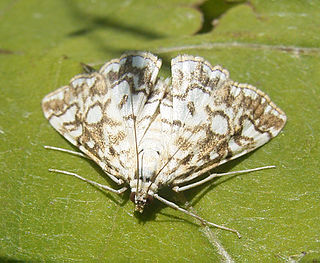
Naarda is a large genus of erebid moths currently encompassing 108 species. Initially identified by Francis Walker in 1866, it is in the family Erebidae. Somewhat ruddy in appearance, this genus is distinguishable for its generally slender thorax and abdomen, and straight, porrect labial palpi. Most species are a light tan color, but shading can reach as deep as a charcoal, with muddy yellow, conspicuous reniform, orbicular stigmata featured on the forewings, sometimes reflected bilaterally superior.

Nymphicula is a genus of moths of the family Crambidae.

Pagyda is a genus of moths of the family Crambidae.

Paracymoriza is a genus of moths of the family Crambidae.

Parapoynx is a genus of moths of the family Crambidae described by Jacob Hübner in 1825.

Psara is a genus of moths of the family Crambidae described by Snellen in 1875.

Parotis is a genus of moths of the family Crambidae.

Symmoracma is a monotypic moth genus of the family Crambidae described by Edward Meyrick in 1894. Its only species, Symmoracma minoralis, described by Snellen in 1880, is found in Indonesia, Papua New Guinea, Taiwan, China and Australia, where it has been recorded from Queensland.

Tabidia is a genus of moths of the family Crambidae described by Pieter Cornelius Tobias Snellen 1880.
Heterogramma is a genus of moths of the family Noctuidae. The genus was erected by Achille Guenée in 1854.

Parapoynx diminutalis is a species of moth of the family Crambidae described by Pieter Cornelius Tobias Snellen in 1880. It is endemic to south-east Asia, including the Northern Territory, Queensland and New South Wales in Australia, but has since been found in the United Kingdom and the United States. It is also found in Africa, where it has been recorded from Egypt, Sudan, Ethiopia, Kenya, Uganda, Tanzania, Zambia, Zimbabwe, Malawi, South Africa, Botswana, Angola, the Republic of the Congo, Nigeria and Madagascar.

Acentropinae is a fairly small subfamily of the lepidopteran family Crambidae, the crambid snout moths. Species of this subfamily are exclusively found in wetlands and aquatic habitats.
Elophila difflualis is a moth of the family Crambidae. The species was first described by Pieter Cornelius Tobias Snellen in 1880. It is found in South-East Asia, in Australia and Réunion but has also be introduced to the United Kingdom.

Diduga flavicostata is a moth of the family Erebidae first described by Snellen in 1879. It is found on Java, as well as in Australia, India, Sri Lanka, Myanmar, Malaysia, China and Japan.

Tabidia insanalis is a moth of the family Crambidae. The species was described by Pieter Cornelius Tobias Snellen in 1879. It is found on Borneo, Sulawesi, Papua New Guinea and Queensland, Australia.

Maliattha ritsemae is a moth of the family Noctuidae. It was described by Samuel Constantinus Snellen van Vollenhoven in 1880. It is found on Sulawesi, Ambon Island, as well northern Australia and New Hebrides.
Lyclene pudibunda is a moth of the subfamily Arctiinae. It was described by Pieter Cornelius Tobias Snellen in 1880. It is found on Sumatra and Borneo and in the north-eastern Himalayas. It is found in a wide range of habitats, including secondary vegetation, dipterocarp forests and heath forests in the lowlands, as well as lower montane forests.
Pagyda calida is a moth in the family Crambidae. It was described by George Hampson in 1898. It is found on Peninsular Malaysia and Borneo.
Syllepte abyssalis is a moth in the family Crambidae. It was described by Snellen in 1892. It is found in New Guinea, Indonesia and Australia, where it has been recorded from Queensland.

Eublemma pudica is a moth of the family Erebidae first described by Snellen in 1880. It is found in Sri Lanka, India, Fiji and Australia.












